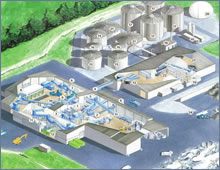Having to face Europe’s highest recycling targets, Scotland is at the forefront of investing in relatively new technologies like anaerobic digestion.
Scotland’s largest ever anaerobic digestion (AD) facility, capable of handling around 105,000 tonnes a year, has been given planning permission and will come online in 2012.
With the escalation of landfill tax, a growing emphasis on recycling and recovery, new government incentives to encourage renewable energy from waste, and innovative new technologies coming on stream, the opportunities for small and medium sized waste contractors have never been greater.
Nowhere is this truer than in the area of commercial and industrial waste, where the volumes being generated in the UK are four to five times higher than municipal solid waste. And nowhere are the commercial and environmental pressures greater than in Scotland, where the recycling targets are the highest in Europe.
So the recent news that planning permission has been given for Scotland’s largest ever anaerobic digestion facility, capable of handling around 105,000 tonnes a year, should be a real inspiration for smaller contractors looking to diversify into new waste streams and take advantage of a whole new market.
Led by Banks Developments in partnership with recycling firm Scotwaste, the AD plant will be built as part of a £70m energy-from-waste facility at Pond Green Energy Park, located to the south west of Bathgate. The waste processing and recycling facility as a whole will have a design capacity of 200,000 tonnes per year. Although the waste input will mainly be commercial, the site is particularly well suited to serve the West Lothian municipal waste contract as well as all of the existing Scotwaste inputs. It will also generate enough electricity to power more than 7,000 homes and enough heat to serve the equivalent of 9,000 homes.
Situated strategically between Glasgow and Edinburgh within the central belt of Scotland, the location is well placed to serve areas of high population density generating large volumes of organic waste. The site is jointly owned by Scotwaste, a family run business that first began recycling in 1972 and has since grown into West Lothian’s leading recycling company with an outstanding landfill diversion rate in excess of 70%. They partnered with Banks Developments, one of the largest and most successful UK development companies with a long track record in waste resource management.
The site also has all the natural advantages of good transport links, the right size of footprint and few competing facilities. But AD is relatively new in the UK – and although there are around thirty plants at various stages of development, only three are operational and of scale similar to the proposed Pond site. So getting the right specialist advice early on in the process was critical.
Early input
Wardell Armstrong, an engineering and environmental consultancy with specialist expertise in waste resource management, were called in by Banks Developments to provide early input on energy from waste, to advise on the various technological AD options, and to prepare a financial model for the proposed facility Discussions on how best to take the project forward soon led to a commission to carry out a full environmental impact assessment including landscape and visual aspects, human health, noise, dust, air quality, drainage issues and transport. Wardell Armstrong were also briefed to carry out the design of the AD facility. A number of specialists from different disciplines within the consultancy were involved in the project including environmental scientists, landscape architects, drainage engineers, ecologists and air quality and noise experts.
The human health assessment was especially important to satisfy and reassure the local authority and population of the safety of this kind of technology. The measures proposed to control emissions – including the ventilation system, dust filters, scrubber, biofilter, 16m high stack and operating within closed buildings under negative air pressure to minimise potential odours escaping – will ensure a high level of protection to the nearest residents situated just over 300 metres from the site.
Air quality assessment and modelling were also essential to ensure that emissions from the stack, which include air from the ventilation system, the gas engines and the biofilter (designed to clean all the air from the process buildings) would be suitably dispersed and of no significant impact. The construction materials and layout of the facility will similarly ensure that the noise levels are well within those required by West Lothian Council for such a high profile building development. The transport assessment also cnfirmed that trucks would be using major routes rather than residential roads, and that additional lorry loads would have no significant impact on the local road network
One useful way of reassuring local residents and addressing any concerns was a public exhibition of the plans, where anyone could come along, take a look, ask questions, and find out more about the environmentally friendly, low impact technology involved in AD.
Intelligent use of waste
From the reception hall where the waste enters the site, the facility design sees it progressing to a mechanical separation and sorting stage, where recyclates are removed and held in a storage area. The separated organic waste is then treated within the mixing and dewatering building to remove further impurities and produce a pumpable slurry for the AD process. Before reaching one of the three large anaerobic digestion tanks the slurry is treated in the buffer and hydrolysis tank to immobilise pathogens and produce a natural balance for pH and other chemical variables to meet the requirements of the digesters.
The anaerobic digestion which then takes place in the 20 metre tall digester tanks is an entirely natural biological process. It involves stabilising organic waste in the absence of air, and transforming it into biogas (approximately 60% methane and 40% CO2) and digestate. The slurry is continually mixed by a slow rotating agitator to prevent heavier sludge from settling and to maintain consistency. During this time it’s broken down by micro organisms – naturally occurring bacteria that regard the waste material as food. They release biogas which is drawn off into a storage unit. The slurry remains in the digester until the digestion process is completed, gradually passing out into a strip tank where it’s aerated by having air pumped through it to halt the production of methane.
A low pressure gas storage facility captures the methane, CO2 and other gases that are produced – preventing them from being released to atmosphere and holding them ready for use in powering a combined heat and power plant on the site. The plan is to create a self-sustaining plant and also to be a net energy producer, with the potential for grid connection and export of energy.
The solid digestate that’s produced as the result of the AD process is dewatered and then heat dried to produce a stabilised odourless organic material. Once further matured in aerobic conditions for two to four weeks, this material can be used as an organic soil conditioner as restoration material for the remediation of brownfield sites. Other possible uses include refuse-derived fuel for the generation of electricity, or feedstock for the production of bio-diesel. The liquid fraction of the slurry is de-watered in a screen press to remove any remaining solids before being returned to the process water tank to be re-used in the AD process.
Plans also include an education centre where school children and other visitors can find out more about the AD processes, increase their understanding of recycling, and see for themselves the benefits of the intelligent use of waste.
“This development drives us firmly forward into the twenty first century” said Stewart Melrose, director at Scotwaste. “As a local business and employer we’ve built up a good customer base and a good reputation, but we wanted to go much further by using new technology to convert the waste streams in the area into a sustainable resource.”
Colin Anderson, MD of Banks Property Development said: “This decision is a landmark in the drive to deliver Scotland’s zero waste strategy. Pond Green Energy Park will provide West Lothian and the wider central belt with a local solution to its own waste, as well as delivering renewable energy to fuel businesses and homes, and supporting economic growth. Wardell Armstrong’s specialised expertise has been critical to our success so far. We hope to start construction during 2011, with the facility coming on line in 2012.”









